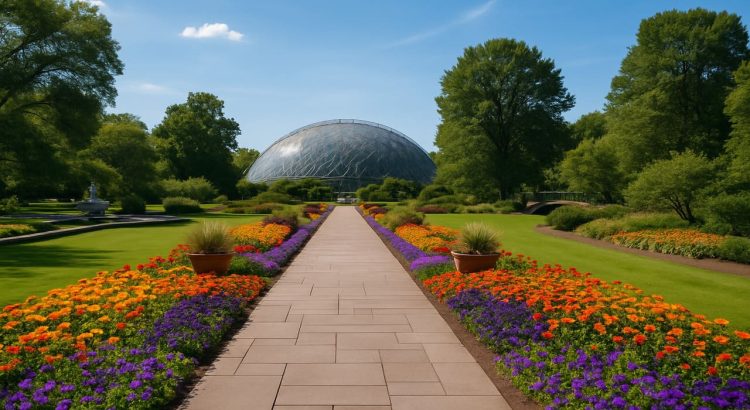Visit MarkTwain Lake – The Missouri Botanical Garden stands as one of the most historically significant and scientifically respected botanical institutions in the world. Founded in 1859 by philanthropist and botanist Henry Shaw. It is not only the oldest botanical garden in continuous operation in the United States but also a center for plant conservation, botanical research, and environmental education.
Spanning over 79 acres, this verdant oasis offers visitors an escape from urban hustle into a world of color, tranquility, and learning. Whether you’re a botanist, a family on a weekend outing, or a tourist searching for natural beauty. The Missouri Botanical Garden has something to offer every soul.
An Immersive Garden Experience
The Missouri Botanical Garden is a symphony of themed landscapes. At the heart of the garden lies the Climatron, a geodesic dome greenhouse that replicates a tropical rainforest environment. The Climatron was the first geodesic dome greenhouse of its kind when it opened in 1960, and it remains a landmark in botanical architecture.
Another gem within the garden is the Japanese Garden known as Seiwa-en. Spanning 14 acres, it is one of the largest Japanese gardens in North America. Designed with authenticity and tranquility in mind, it features koi-filled lakes, curved bridges, traditional lanterns, and winding paths through carefully pruned trees and flowering plants. The Japanese Garden is a sanctuary of peace that reflects centuries-old horticultural traditions.
Other notable garden areas include the English Woodland Garden, the Victorian District, and the Children’s Garden, where younger visitors can explore interactive exhibits and connect with nature hands-on.
Also Read : Castlewood State Park: Discover Nature’s Beauty for Your Next Outdoor Retreat
A Hub for Botanical Science and Conservation
Beyond its public-facing beauty, the Missouri Botanical Garden is a leader in plant science and conservation. It houses one of the largest herbarium collections in the world, with over 7 million specimens. Many of which date back centuries and provide invaluable data for taxonomy and ecology.
The Garden is home to the William L. Brown Center, which conducts research on the relationships between people, plants, and culture. Scientists at the Garden also lead international efforts to catalog plant biodiversity, especially in regions like Madagascar, Central America, and Southeast Asia areas rich in plant life but threatened by deforestation and climate change.
The institution’s long-standing mission is to preserve and protect plant diversity and to advocate for sustainable ecosystems around the globe. It serves as a voice for botanical literacy in a world where environmental awareness has never been more urgent.
Events, Festivals, and Seasonal Attractions
The Missouri Botanical Garden hosts numerous seasonal events that enhance its allure throughout the year. Spring is marked by the blooming of tulips, daffodils, and cherry blossoms, which signal the arrival of warmer days. Summer brings the Whitaker Music Festival, where locals gather to enjoy free outdoor concerts under the stars.
In autumn, the garden explodes in hues of gold and crimson as the trees shed their leaves in a spectacular display of color. The popular Japanese Festival celebrates cultural traditions with food, tea ceremonies, martial arts demonstrations, and more.
Come winter, the Garden transforms once again during Garden Glow. A dazzling nighttime spectacle of over a million lights adorning the trees, pathways, and historic buildings. It’s one of the most anticipated holiday events in the St. Louis area and draws thousands each year.
Read More : Bass Never Sleeps: Inside Slakthuset’s Underground Rave Realm
Education and Community Engagement
A pillar of the Missouri Botanical Garden’s mission is public education. The Garden offers a wide range of workshops, lectures, and tours tailored for various age groups and interests. Topics range from organic gardening and plant identification to climate resilience and sustainable landscaping.
For local schools, the Garden provides nature-based curriculum support, field trips, and outreach programs to nurture young minds and foster environmental stewardship. Adult learners can enroll in horticultural certificate programs or attend seminars by leading scientists and garden designers.
In addition, the Garden’s community outreach includes urban greening initiatives and partnerships with underserved neighborhoods to promote access to green spaces, fresh produce, and environmental justice.
The Garden’s Role in a Changing Climate
As the challenges of climate change become more urgent. The Missouri Botanical Garden is positioning itself not just as a place of beauty but as a force for sustainability. With initiatives like zero-waste operations, native plant promotion, and urban ecology projects, the Garden is actively working to reduce its environmental footprint while empowering visitors to do the same.
The future of the Missouri Botanical Garden lies not just in its ability to preserve the past, but in its commitment to inspiring future generations to protect the Earth’s green heritage.




